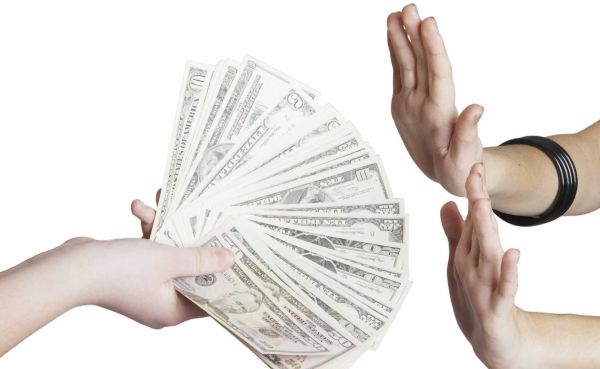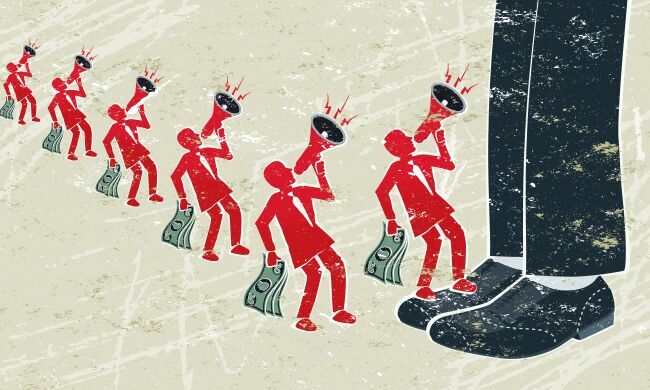U.S. Senator Russ Feingold’s campaign website proclaims that the Senator, “has been a tireless leader in bipartisan efforts to restore fiscal discipline in Congress.” Yet now Senator Feingold wants to divert millions in government funds to pay for a project that a majority of taxpayers don’t want and which, left alone, citizens would pay for voluntarily.
Currently, political campaigns for the U.S. House and Senate are are paid for voluntarily by the public, through contributions to candidates, political parties, and citizens’ groups. The taxpayer doesn’t pay a dime. However, presidential races are substantially subsidized by taxpayers, to the tune of approximately $60 million or more per year. Over the years, taxpayers have been forced to subsidize three presidential campaigns by John Hagelin of the Natural Law Party, whose platform was based on a call for more transcendental meditation; seven presidential campaigns by Lyndon LaRouche, including one run from Federal Prison; and two by Lenore Fulani of the defunct New Alliance Party. They have also been forced to pay for runs by “major party candidates” such as Larry Agran, Milton Schaap, Keating Five Senator Alan Cranston, and many other long-forgotten figures. They have paid for balloon drops at national party conventions, and campaign attack ads – all told, over $2.4 billion in current dollars.
This week, Senator Feingold introduced legislation that could more than quadruple the amount that the Federal government earmarks in tax returns to pay for presidential candidate campaigns. Representatives Marty Meehan and Chris Shays introduced identical legislation in the House. But why?
According to the legislators press release, it is to, “to protect the integrity of the electoral process.” Candidates who are funded by voluntary contributions, according to Feingold, are, “overly dependent on private donors.” Yet the Democratic Party’s most recent presidential nominee, John Kerry (not to mention current Democratic National Committee Chairman Howard Dean) refused to take taxpayer subsidies for their campaigns, and no one thought that suddenly made them more corrupt. The fact is, this rationale is laughable on its face. No one – including Senator Feingold – thinks John Kerry would be any more or less corrupt if he used taxpayer money to pay for his campaign. At least it is doubtful that Senator Feingold would say that to Senator Kerry’s face.
Moreover, the public appears to oppose taxpayer subsidies to campaigns. Money for the taxpayer subsidies currently comes from a checkoff that taxpayers can make on their tax returns, directing $3 to pay for campaigns. This does not raise their taxes – it merely diverts $3 of their taxes to campaign subsidies. Even though it does not raise their taxes, in 2004 less than 10% of taxpayers directed money to the fund – a rather damning statistic. Public opinion polls further demonstrate public opposition. For example, a Rasmussen Poll of 500 voters taken in February 2006 for the Center for Competitive Politics found that voters opposed “public funding” of campaigns by a 59-26% margin. Polls which use the more accurate term, “taxpayer” funding, find even lower support – less than 20%.* Even when the questions are biased in favor of government financing, support remains tepid. For example, in 1994 a CBS/New York Times poll asked, “In order to reduce congressional campaign contributions from special interests, would you favor or oppose public financing to help congressional candidates in their campaigns?” Despite the dubious assertion that this would reduce the power of “special interests,” respondents opposed tax financing by a 54%-38% majority. Only by introducing one-sided discussions of the alleged benefits of tax financing – always called “public financing” – are supporters able to generate supportive poll numbers.** And as we have seen, these numbers are not backed up by actual voter behavior when it comes to checking their tax returns.
While few participate, the current system allows a small percentage of taxpayers – under 10% in recent years – to divert millions in tax revenue to funding presidential campaigns – campaigns which, as John Kerry, Howard Dean, and George Bush have shown by their refusal to take the tax money, the public is quite willing to fund voluntarily.
Nevertheless, Senator Feingold and Congressmen Shays and Meehan propose that we dramatically increase the size of public subsidies. Currently, in the primaries, candidates receive a dollar for dollar match from the federal treasury for the first $200 of any contribution, and in return agree to limit their spending to approximately $45 million during the primary season. The Feingold proposal would raise the match to 4-1 — for example, each $100 contribution to a candidate would trigger $400 in added government subsidies on political campaing – and raise the spending cieling to $150 million. Subsidies for the general election, when candidates are just given the money without first raising voluntary contributions, would rise by about 33%, from approximately $75 million to $100 million, and be indexed for inflation. The earmark would increase from $3 to $10 to pay for this. But how to get people to check the box? Currently, more than 90% of paper tax filers say no to tax financing, so naturally major electronic filing software manufacturers, trying to make their software easy to use, sometimes use “no” as the default option (which the taxpayer can override). The Feingold bill would prohibit this practice, inconveniencing millions of taxpayers in an effort to get them to earmark funds to campaign subsidies. Further, the bill would provide up to $10 million per election for a public propaganda campaign to convince more people to support the earmark.
Leaving aside fundamental philosophical questions of whether it is ever proper to force taxpayers to support the political speech of candidates they oppose, or ignoring the particulars of this proposal, the question of tax financing of campaigns becomes one of priorities. In the great scheme of the federal budget, the subsidy is not a lot – although even at current levels it is enough to fund, for example, the entire budget of the Consumer Products Safety Commission. Should it be increased by as much as 400 percent? In Russ Feingold’s home state of Wisconsin, the Ash Borer beatle threatens to destroy millions of American Ash trees – it is believed that within a few years, Ash trees could go the way of the Dutch Elm. It is a natural disaster in the making, and the states lack the money to fight the beetle. Where should the money be spent? Every dollar spent to subsidize political campaigns is a dollar not spent on body armor for troops in Iraq, or relief for hurricane victims, or returned to taxpayers as credits for college tuition, or any number of priorities.
The question is whether or not subsidizing political campaigns the best use of tax dollars. What do you think?
* Tarrance Group, June 1993: “Do you favor or oppose using taxpayer dollars to pay for political campaigns of candidates running for Congress?” F – 18%; O – 77%, U – 5% (sample 1000). CBS/NYTimes Poll: “Some people have proposed public financing of political campaigns – that is, using only tax money to pay for political campaigns. Would you favor or oppose public financing to pay for political campaigns? April 1997, F – 18%; O – 78%; U – 4% (sample 1347); February 2000, F – 20%; O- 75%; U – 5% (sample size 1225).
**A review of many polls can be found in this report by the Campaign Finance Institute.














